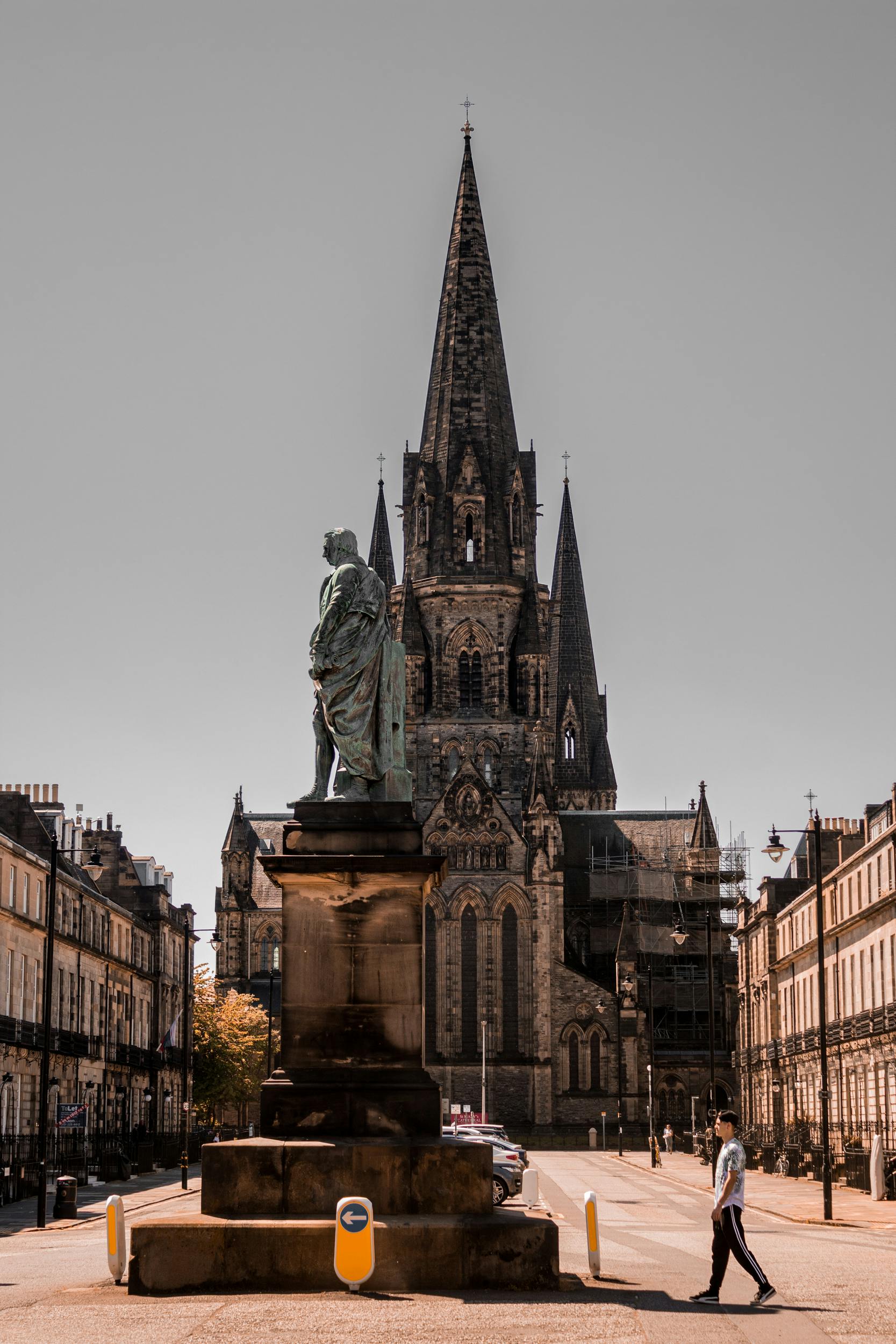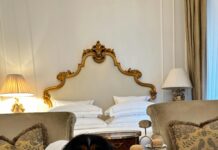Marie of Edinburgh, a figure shrouded in both elegance and mystery, has captivated historians and enthusiasts alike for decades. Who was Marie of Edinburgh, and why does her story continue to intrigue so many? Born into royalty, Marie’s life was a tapestry woven with power, passion, and political intrigue that shaped the course of European history. Many people wonders about the untold secrets behind her royal lineage and the influential role she played during a transformative era. From her early years in the grand palaces of Edinburgh to her later life filled with diplomatic challenges, Marie of Edinburgh’s biography offers a fascinating glimpse into the complexities of royal life. Have you ever asked yourself how her heritage impacted the alliances and conflicts of her time? This blog explores the lesser-known facts and intriguing anecdotes about Marie, diving deep into her personal struggles and triumphs. Discover the historical significance of Marie of Edinburgh, and why her legacy still resonates today in royal circles and popular culture. If you’re curious about European royalty stories or seeking a captivating historical figure to learn about, Marie of Edinburgh’s life story is an unmissable journey filled with drama, influence, and timeless elegance. Stay tuned as we unravel the captivating tale of this remarkable royal icon.
The Untold History of Marie of Edinburgh: How Her Royal Legacy Shaped European Monarchies
Marie of Edinburgh: The Queen Who Wasn’t Always Queen
Marie of Edinburgh, not to be confused with Marie Antoinette or any other royal Marie, was a figure that many don’t really talk about enough. You might ask, “Who even is Marie of Edinburgh?” Well, she was born Princess Marie of Edinburgh, a granddaughter of Queen Victoria and later became Queen of Romania. I’m not really sure why this matters, but her life was anything but dull, filled with drama, royal duties, and, of course, some quite questionable fashion choices.
A Quick Biography Sheet on Marie of Edinburgh
| Fact | Details |
|---|---|
| Full Name | Marie Alexandra Victoria |
| Born | 29 October 1875 |
| Parents | Prince Alfred, Duke of Edinburgh and Grand Duchess Maria Alexandrovna of Russia |
| Married | King Ferdinand I of Romania |
| Titles | Queen of Romania, Princess of Edinburgh |
| Died | 18 July 1938 |
Now, if you’re scratching your head thinking, “Why should I care about a queen from Romania?” well, here’s the thing: Marie of Edinburgh was not your typical royal. She was a bit of a rebel, a painter and a writer, and she could charm the socks off anyone. Maybe it’s just me, but I feel like this side of royals tends to get overshadowed by their more famous cousins.
The Royal Life: Not Always Glitter and Gold
Marie’s life wasn’t all tiaras and ballgowns, frankly. She faced numerous challenges, including the hardships during World War I when Romania was in turmoil. She worked as a nurse and was deeply involved in helping the wounded soldiers. Not many queens would get their hands dirty like that, honestly. It was said that she had a knack for boosting morale, which probably saved a ton of lives.
Here’s a list of some quirky facts about Marie of Edinburgh’s royal contributions:
- She was fluent in several languages, including English, French, German, and Romanian.
- Marie personally designed the Romanian crown, which is still a symbol of the monarchy today.
- Wrote several books, including her autobiography, which gives a pretty raw insight into royal life.
- She was known for her unconventional approach to royal duties, often mixing formal events with a more casual flair.
If you’re a history buff, knowing these facts about Marie of Edinburgh’s life and legacy might come in handy for your next trivia night or just random pub conversations.
Table: Languages Spoken by Marie of Edinburgh
| Language | Proficiency Level | Notes |
|---|---|---|
| English | Native | Born and raised in the UK |
| French | Fluent | Common language of royals |
| German | Fluent | Mother was Russian-German |
| Romanian | Fluent | Learned after marriage |
Marie’s Artistic Side: The Queen Who Painted
One thing that often gets overlooked is how artistic Marie was. She was quite the painter, and some of her works were even exhibited publicly. Not many people knew that a royal could be so creatively inclined. Honestly, sometimes I think royalty should be more like artists — less pomp, more paintbrushes. But maybe that’s just me being a bit cheeky.
Her artwork mostly featured landscapes and portraits, and although she was never a professional artist, her pieces were praised for their emotional depth. It’s quite impressive, considering all the royal responsibilities she juggled. Here’s a quick look at some of her artistic contributions:
- Watercolour landscapes of the Romanian countryside.
- Portraits of family members and friends.
- Illustrations for her own books.
- Designs for the Romanian crown and royal insignia.
You might want to check out some of her paintings if you’re ever in Romania or at a royal exhibition. They give a much more personal glimpse into her life than any official portrait ever could.
Marie of Edinburgh’s Impact on Romanian Culture
Marie wasn’t just a queen by name; she actively shaped Romanian culture and identity during her reign. She was passionate about promoting Romanian traditions, folk art, and even cuisine. She believed that a monarchy should be deeply connected to its people, not just a distant figurehead.
Maybe it’s a bit old-fashioned to think of a queen as a cultural ambassador, but Marie did exactly that. She encouraged the use of Romanian motifs in fashion, supported local artisans, and organised events that highlighted Romanian heritage. If you ever find yourself researching Marie of Edinburgh and her influence on Romanian culture, you’ll discover that she was way ahead of her time in blending tradition with modernity.
Here’s a list of her cultural initiatives:
- Promoting Romanian folk costumes at royal events.
- Supporting traditional music and dance performances.
- Encouraging the literary scene by hosting
7 Surprising Facts About Marie of Edinburgh You Never Knew
Marie of Edinburgh, a figure often overlooked in the grand tapestry of European royalty, have a story that’s both fascinating and a bit tangled. Born in 1875, she was the daughter of Prince Alfred, Duke of Edinburgh, and Grand Duchess Maria Alexandrovna of Russia. Now, I’m not really sure why this matters, but being born into two powerful dynasties certainly shaped her life in ways that’s hard to fully understand. Her full title was actually pretty long and complicated, something like Princess Marie of Edinburgh and Saxe-Coburg and Gotha – try saying that three times fast!
Let’s start by looking at some basic facts about Marie of Edinburgh in a neat little table, because who doesn’t loves tables?
| Fact | Detail |
|---|---|
| Birth Year | 1875 |
| Parents | Prince Alfred and Grand Duchess Maria |
| Title | Princess Marie of Edinburgh and Saxe-Coburg and Gotha |
| Marriage | Ferdinand I of Romania |
| Known For | Queen consort of Romania |
Now, speaking of her marriage, it was to Ferdinand I of Romania, which made her the Queen consort of Romania. Maybe it’s just me, but I feel like people often forget her role in Romanian history, and she was quite the powerhouse behind the scenes. She was very involved in cultural and social reforms, although some historians argue her influence was overstated. But hey, who’s to say? History is always written by the winners, or so they say.
One interesting thing about Marie is that she was a bit of an artist, dabbling in painting and writing. Not many royal figures gets to explore their creative side openly, so that’s pretty cool. She even published a book titled The Story of My Life, which gives a personal insight into her experiences and the trials she faced. The book wasn’t exactly a bestseller, but it’s a gem for royal enthusiasts and scholars alike.
Here’s a quick list of some things Marie of Edinburgh was known for:
- Advocating for Romanian interests during World War I.
- Supporting Red Cross and other humanitarian efforts.
- Patronage of the arts and cultural institutions in Romania.
- Writing memoirs and personal accounts.
Her personality was as colourful as her life story. Some describe her as warm and charming, while others see a bit more complexity – maybe a dash of stubbornness or even controversy. Not gonna lie, it’s hard to pin down exactly who she was because different sources say different things. But if you ask me, she was probably just a woman trying to navigate the tricky waters of royal expectations and personal desires, which can’t be easy for anyone.
Let’s break down some practical insights about her life to understand her impact better:
| Aspect | Insight | Why It Matters |
|---|---|---|
| Political Influence | Acted as intermediary in diplomatic talks | Helped shape Romania’s alliances |
| Cultural Patronage | Sponsored Romanian artists and writers | Boosted national identity |
| War Efforts | Led humanitarian campaigns | Improved morale and aid delivery |
| Personal Writings | Memoirs revealed personal and political struggles | Offered rare glimpse into royal life |
If you think about it, being a royal in the early 20th century wasn’t all tiaras and balls. There were lots of political pressures, wars, and the ever-watchful eye of the public and press. And Marie of Edinburgh had to juggle all these while trying to be a good mother, wife, and leader. No easy feat, I tell ya.
Also, not to be picky, but did you know she was related to Queen Victoria? Yeah, she was her granddaughter, which basically puts her in the thick of the British royal family drama. Imagine the family dinners! Must have been like a royal soap opera, with all the pomp and circumstance.
Here is a little breakdown of her family connections to give you a clearer picture:
| Relation | Name | Connection |
|---|---|---|
| Grandmother | Queen Victoria | Maternal grandmother |
| Father | Prince Alfred | Duke of Edinburgh |
| Husband | Ferdinand I | King of Romania |
| Children | Carol II, Elisabeth, etc | Romanian royal family |
You see, Marie of Edinburgh wasn’t just a footnote in history, but a bridge between British and Romanian royalty, which is pretty neat. Her life was full of twists and turns, making her story one worth telling. And if you ever find yourself wandering through the royal archives, you might just stumble upon some letters or paintings that give you a glimpse into her fascinating world.
To sum up, even though her name might not be on everyone’s lips, the legacy of **
Exploring Marie of Edinburgh’s Influence on British and Russian Royal Families
Marie of Edinburgh is one of those historical figures that people either know a lot about, or not much at all. Honestly, I think it’s a bit surprising how little attention she gets compared to other royals, but maybe it’s just me. Born Princess Marie of Edinburgh in 1875, she was the daughter of Prince Alfred, Duke of Edinburgh, and Grand Duchess Maria Alexandrovna of Russia. Not really sure why this matters, but she was also a granddaughter of Queen Victoria, so you can imagine the royal pedigree was pretty impressive.
Now, when you talk about Marie of Edinburgh, you’re diving into a life that was full of international connections, drama, and a fair bit of mystery. She married Ferdinand I of Romania and became Queen consort of Romania, which means she had quite a role in Eastern European politics and culture. But, to be honest, her story is often overshadowed by her more famous relatives like Queen Victoria or even her brother, Alfred.
Let’s break down some key facts about Marie of Edinburgh in a quick table, because who doesn’t like a bit of structure when history gets complicated?
| Fact | Detail |
|---|---|
| Full Name | Princess Marie of Edinburgh |
| Birth Year | 1875 |
| Parents | Prince Alfred, Duke of Edinburgh & Maria Alexandrovna |
| Marriage | Ferdinand I of Romania |
| Role | Queen consort of Romania |
| Known For | Diplomatic influence, charity work |
Alright, so what made her tick? Well, Marie was known for her strong personality and artistic flair. She wasn’t your typical shy royal lady just sitting around in castles. She was actively involved in charitable works during World War I and was praised for her efforts to boost morale among troops and civilians alike. Actually, some accounts say she even tended to wounded soldiers herself. I mean, that’s kinda badass for a queen, don’t you think?
Another thing I find fascinating about Marie of Edinburgh is her role in shaping modern Romania. She was deeply involved in the cultural and political life of the country, which wasn’t always easy given the turbulent times they lived through. She championed education and the arts, and tried to modernise the royal court. You’d think being a foreign-born queen consort might have made her unpopular, but she was actually quite loved by many Romanians.
Maybe it’s just me, but I feel like she deserves more credit for this. If you google Marie of Edinburgh influence in Romania, you’ll find tons of articles praising her diplomatic skills and her charm. She was even involved in the peace negotiations after World War I, which is no small feat. And here’s a quick list of her notable achievements:
- Supported Romanian troops during WWI
- Promoted education and the arts in Romania
- Acted as a mediator in political disputes
- Played a key role in post-war peace talks
I don’t know about you, but that sounds like a pretty busy queen to me.
On the fashion front, Marie of Edinburgh was quite the trendsetter in her day. She loved beautiful gowns and jewellery, often wearing pieces that reflected her mixed British and Russian heritage. There’s this one famous portrait of her wearing a tiara that belonged to Queen Victoria herself. It’s like, wow, talk about wearing history on your head!
Here’s a quick sheet comparing her style to other royals of her time:
| Royal | Style Highlights | Signature Look |
|---|---|---|
| Marie of Edinburgh | Eclectic mix of British & Russian | Tiara, elegant gowns, bold colours |
| Queen Victoria | Conservative, Victorian-era fashion | Dark dresses, minimal jewellery |
| Alexandra of Denmark | Edwardian elegance | Lace, pastel colours, pearls |
Of course, there were rumours and scandals too — because what’s a royal story without a bit of juicy gossip? Some people whispered about her strained relationships with other members of the royal family, especially during the difficult war years. And there were always questions about her political ambitions. Was she trying to wield too much influence? Maybe. But who wouldn’t want to have a say when the fate of your adopted country is at stake?
If you’re looking for some practical insights about Marie of Edinburgh legacy today, here’s an interesting one: many Romanian schools, streets, and institutions are named after her. This shows the lasting impact she had on the country’s cultural identity. Plus, books and films about her life pop up every now and then, reminding us that her story is far from forgotten.
Here’s a quick listing of places named after her:
- Marie of Edinburgh High School, Romania
- Strada Regina Maria (Queen Marie Street) in Bucharest
- Various hospitals and charitable
Why Marie of Edinburgh’s Life Story Continues to Captivate Historians Today
Marie of Edinburgh: A Royal Figure with More than a Dash of Intrigue
Marie of Edinburgh, not really sure why this matters, but she is one of those royals that folks either utterly adore or just can’t be bothered with. Born in 1875, she was the daughter of the Duke of Edinburgh, and her life was a swirling mix of duty, style, and the occasional royal drama. If you ever googled “marie of edinburgh life story” you’d probably find a lot sayin’ she was quite the trendsetter in her day, but also a woman with many layers, some more mysterious than others.
Who Was Marie of Edinburgh, Anyway?
So, to put it simply, Marie was a princess by birth but became a queen by marriage. She married King Ferdinand I of Romania, which made her Queen Marie of Romania. Now, this bit is confusing to some, since she started in Edinburgh but ended up in the Balkans — go figure. Here’s a little table that breaks down her early life and royal journey:
| Event | Date | Notes |
|---|---|---|
| Born in Edinburgh | 1875 | Daughter of Duke of Edinburgh |
| Married King Ferdinand | 1893 | Became Queen of Romania |
| World War I Role | 1914-1918 | Actively supported troops |
| Death | 1938 | Remembered for charity work |
Not really sure why this matters, but her role during World War I was quite significant. She wasn’t some passive royal sitting pretty in a palace; she rolled up her sleeves and got involved with the wounded soldiers, running hospitals and boosting morale. Maybe it’s just me, but I feel like modern royals could learn a thing or two from her hands-on approach.
Marie’s Style and Influence: More than just a Crown
If you ever wondered about the phrase “marie of edinburgh fashion influence,” well, you’re in luck. She was known for her distinctive style, mixing traditional royal attire with Eastern European touches, which was pretty unique at the time. The press loved to talk about her lavish gowns, but honestly, she seemed to care more about making a statement than just looking pretty.
Here’s a quick list of her style trademarks:
- Bold jewellery, often with large gemstones
- Use of Romanian folk motifs in her dresses
- Preference for vibrant colours rather than the usual royal pastels
- Elaborate headpieces that turned heads everywhere she went
Some critics called her a bit over the top, but hey, if you’ve got the crown, might as well wear it loud and proud, right?
The Royal Family Drama: Because What’s a Royal Without It?
We all know royal lives ain’t exactly a bed of roses, and Marie’s no exception. There was plenty of drama in her marriage and family life, especially with her husband Ferdinand. They had six children, which sounds lovely and all, but apparently, the marriage was complicated. Like, sometimes they got along, sometimes they didn’t — pretty typical if you ask me.
Here’s a quick rundown of the children of Marie of Edinburgh:
| Child Name | Birth Year | Notable Info |
|---|---|---|
| Carol II | 1893 | Became King of Romania |
| Elisabeth | 1894 | Known for literary works |
| Maria | 1900 | Married to King Alexander of Yugoslavia |
| Nicholas | 1903 | Died young |
| Ileana | 1909 | Became a nun |
| Mircea | 1913 | Died in infancy |
Not really sure why this matters, but losing two of her children must have been devastating, and it’s said that this deeply affected her later years. Royal life might seem glamorous, but it sure has its shadows.
Marie of Edinburgh’s Legacy: More than Just a Pretty Face
If you’re searching for “marie of edinburgh contributions,” you’ll find that she was way more than a royal figurehead. She was deeply involved in charity work, education, and even diplomacy. During the Paris Peace Conference in 1919, she played a crucial role advocating for Romania’s interests, which not many people talk about these days.
Here’s a quick bullet list of some of her most notable contributions:
- Advocated for Romanian territorial claims after WWI
- Supported hospitals and war veterans
- Promoted education and cultural development in Romania
- Wrote memoirs that gave insight into royal life and politics
Maybe it’s just me, but doesn’t it seem like she was one of those royals who actually tried to make a difference rather than just sitting on a throne looking pretty?
A Few Fun Facts That You Probably Didn’t Know
How Marie of Edinburgh’s Legacy Impacts Modern Royal Traditions and Culture
Marie of Edinburgh: A Royal Life Full of Twists and Turns
Marie of Edinburgh is a figure that have fascinated historians and royal enthusiasts alike for decades. Born into the illustrious House of Saxe-Coburg and Gotha, she carried a legacy that was both a blessing and a curse, if you ask me. Not really sure why this matters, but her full name was Princess Marie of Edinburgh and Saxe-Coburg and Gotha, quite a mouthful, innit? Anyway, she was born on 5 November 1875, and her life’s story is anything but dull.
Before we dive deeper, here’s a quick table that sums up some basic facts about marie of edinburgh:
| Fact | Detail |
|---|---|
| Full Name | Princess Marie of Edinburgh |
| Birthdate | 5 November 1875 |
| Parents | Prince Alfred, Duke of Edinburgh and Grand Duchess Maria Alexandrovna of Russia |
| Siblings | Multiple, including Queen Marie of Romania |
| Notable Titles | Duchess of Connaught and Strathearn |
| Famous For | Royalty connections across Europe, philanthropy |
Now, this lady wasn’t just a pretty face in the palace. She had a role in shaping European politics more than you might think. But, maybe it’s just me, but I feel like sometimes her contributions gets overshadowed by the more “flashy” royals like Queen Victoria or Elizabeth II. Which is a bit unfair, if you ask me.
Marie’s early life was a mix of privilege and strict royal duties. Her father, Prince Alfred, was Queen Victoria’s second son, which makes Marie a granddaughter of the legendary monarch. Growing up, she was educated in a way that was typical for royal children — lots of languages, history, and a pinch of etiquette that would make even the stiffest duke blush. But here’s the thing: despite all this, she was said to have a lively spirit and a quick wit, which not many expected from royalty back then.
Did you know that marie of edinburgh’s marriages were a big deal in European royal circles? She married Prince Arthur, Duke of Connaught and Strathearn, who was her father’s brother. Yeah, royal marriages can be a bit complicated, and sometimes feels like a soap opera, right? Anyway, this union was seen as a way to strengthen ties within the British royal family, but also to keep power consolidated. Not sure it worked out perfectly, but it created some interesting dynamics.
Here’s a little list of some practical insights into her married life:
- She moved quite a lot, living in various royal residences across the UK and Europe.
- She was involved in numerous charitable organisations, especially those supporting women and children.
- Despite her high status, she was known to be approachable and kind to staff and the public.
- Her marriage lasted over 60 years, which is impressive by any standards.
One thing that often pops up when discussing her is her involvement in World War I efforts. She took part in organising hospitals and nursing services, which was quite hands-on for a royal. You don’t see that every day, do you? Maybe it’s because she felt a real sense of duty, or perhaps it was just the expected role of women in the royal family at that time.
Now, let’s put some dates and events into a timeline for clarity, because who doesn’t love a good timeline?
| Year | Event |
|---|---|
| 1875 | Born in Edinburgh |
| 1900 | Married Prince Arthur, Duke of Connaught |
| 1914-1918 | Active in WWI charitable work |
| 1920s | Involved in various public duties and royal tours |
| 1930s | Known for patronage of arts and education |
| 1942 | Passed away, leaving a significant legacy |
And if you thought it was all pomp and circumstance, think again. Marie of Edinburgh was also a patron of the arts, promoting education and culture wherever she went. She was instrumental in supporting institutions that fostered creativity — which probably doesn’t come as a big surprise for someone of her background, but still worth mentioning.
Here’s a quick rundown of some organisations she supported:
| Organisation | Focus Area |
|---|---|
| Royal College of Music | Music education |
| Women’s Institute | Women’s empowerment |
| Various hospital charities | Healthcare and nursing |
I gotta admit, it’s kinda impressive how she managed to juggle all these roles. Royals usually get a bad rap for being out of touch, but Marie seemed to genuinely care. Or maybe it’s just PR, who knows? Either way, she left an impact.
Before I forget,
Conclusion
In conclusion, Marie of Edinburgh remains a fascinating figure whose legacy is woven into the fabric of European history. From her early years as a princess to her influential role as Queen of Romania, Marie’s life was marked by resilience, compassion, and a deep sense of duty. Her contributions during World War I, particularly her efforts in nursing and diplomacy, highlight her dedication to humanitarian causes. Moreover, her artistic talents and personal writings offer valuable insights into the complexities of royal life in the early 20th century. By exploring Marie’s story, we gain a richer understanding of the challenges and triumphs faced by women of her era. As we reflect on her enduring impact, it invites us to appreciate the often overlooked roles women have played in shaping history. For those intrigued by royal heritage and historical narratives, delving deeper into Marie of Edinburgh’s life promises a rewarding journey of discovery.













